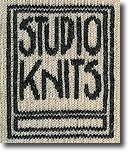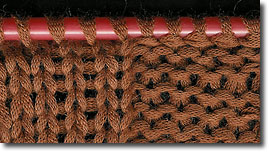 |




Welcome to StudioKnits.com©
Original knitting patterns, delivered instantly to your computer!
------------------------------------------------------
Online knitting book
»
Join news list
| Contact |
FAQ - About us
Home (Patterns)
How to Become an "Expert
Knitter"
*Buy this book
on CD for offline reading!
table of contents
»
epilogue
How I Became an
"Expert Knitter" (cont.)
Bored to sobs in a meeting one day, I was looking through a magazine
and saw what I thought was a crochet suit. I was out of that
boardroom and standing at the counter of the haberdashery department
in a flash. I fished out some black (of course) wool and off I went.
I sat at home with my wool and crochet hook every night after work.
I sat and worked every weekend. I sat and worked for weeks. The fact
that I barely knew how to crochet didn’t mean a thing. I just winged
it. (Years later, looking at the magazine cutting I had kept, I
realised that the fabric was actually woven).
With all my pattern design training and my forced-by-my-pet-dog
knowledge, the shaping was easy. I treated the crochet pieces as
fabric, and the whole thing was a great success. I was stopped in
the street, people searched me out at gatherings to look at my suit,
my friends and even strangers wanted one for themselves. I started
making crochet and knitted things for my nearest and dearest. I
worked at my beloved “Georges” all day and stayed at home, weaving
away when everyone else was out and about. This became very dull, my
social life was shot to hell, but I made a lot of knitwear.
Everything took a new turn when I washed a white sweater I had
finished only a few weeks before. Although I was used to washing my
own wardrobe of luxurious imported knitwear perfectly, this garment
did not survive my careful ministrations. I sent it back to the yarn
company with a bitter complaint, expecting, if not recompense for my
work, at least money for more yarn. Instead, I had a visit from the
sales manager of the yarn company and then, the very impressive
offer to move to Sydney and to design patterns for the company, with
a fantasy wage. Not then, but eventually, the yarn company moved
their headquarters to Melbourne, and so I left “Georges” and started
on a new road. I devised colour ranges, patterns, graphics for
various reasons, ball bands, anything that could be designed to sell
wool, and organised the visual side of the knitting books, garment
patterns, photography and layout.
Now that I look back, I am amazed that any of this occurred. I can’t
imagine what a “formal” training in making knitting patterns could
entail, but mine was entirely from trial and error. I had learned
how to make stitches with yarn and needles, but I never asked anyone
how to do any sort of knitting, and in fact, had worked out for
myself how to decrease and increase. I had only once followed a
knitting pattern (I mean, tried to follow a pattern), and bought my
first stitch pattern book years after I had started making knitwear
for clients. There was no particular reason why I did it this way.
It was just how it all happened.
I know I didn’t like the look of most hand-knitted clothing. It
looked, well, rough, so I wanted to do it differently, and I did
just that. I thought it was neater if I matched the rows as I sewed
the side seam. That could only be done with the right side facing.
No backstitch seams for me. When I made a sleeve, I wanted the top
to fit nicely into the armhole. I didn’t want any little gathered
bits or stretched bits on the seams unless it was part of the look,
and never wanted to add a band that was wavy or had a
higgledy-piggledy pick up row. There were so many things to be
avoided that I soon realised I had worked out a whole set of rules
that I still use to this day. And these home-grown rules were the
ones I used when I wrote patterns and worked with the test-knitters.
Now it wasn’t just down to me, but the fact that the company had
changed direction improved the figures dramatically and there was a
takeover. As often happens, the new owners re-jigged the formula
that had generated the success that attracted them in the first
place and they decided to go down-market.
My enthusiasm plummeted, so I decided to start making garments for
private clients, first at home, then in an amazing dungeon workroom
under my father’s factory, and so on through a series of shops, some
shared with fabric clothing boutiques. Customers came from
everywhere.
I dragooned knitting pals and we sat and wove thousands of webs.
Because I had more or less worked out how to knit without asking for
directions from anyone, I did things in a different way. I
approached a knitting project rather like making a garment from
pieces of unusual fabric. I wanted shape, style and effect more than
wanting to show expertise with wool and needles or an encyclopaedic
knowledge of stitches. I also wanted to create drop-dead beautiful
clothes that no one else could make.
I quickly built up a large client base. I dealt with fascinating,
stylish, demanding, discerning and also critical, and rightly so,
clients, paying big money for their knitwear. They could all afford
to buy whatever they wanted, but there was nothing in the shops like
the knitwear they could get from me and my knitters. Constant
travellers, appearing at all sorts of social occasions, in the
public eye, they wanted to look interesting but not amateurish or
home-made. The last thing in the world that they would have wanted
was to look as if they had sat at home and knitted their own
garments. Everything we produced had to be perfectly knitted and
finished, and, because time is money, all the knitting and making up
had to take the least possible time whilst being perfect. The
garments had to fit exactly on all shapes and sizes.
No one-size-fits-all. It never does.
I took exact measurements and the garments were usually just right,
but we would make minute alterations, however tedious, to achieve
perfection.
Personal taste is a tricky thing, and as I was usually making
knitwear to order, I had to mesh my taste with that of the customer.
The fact that I had many repeat orders for garments was proof that
the combination worked. Some people amassed pieces of my knitwear,
almost like collectors.
Magazine and newspaper editors loved to use my knitwear and it was
always being photographed, before it was owned or afterwards, on the
owners and occasionally, me. It seemed that every time I looked at a
magazine, there was one of our creations.
Then a customer, part of a family-owned knitting yarn company,
approached me to do some patterns for a magazine. This led to a more
permanent arrangement, and eventually I moved my workroom to their
business warehouse, which meant I could knit for my clients, and
also be on the spot for the company. We started producing knitting
books, so there I was again, choosing yarns and colours, doing
patterns, photography, knitting books. The lot!
NEXT
PAGE >> chapter
page: 1 | 2 |
3 |
|